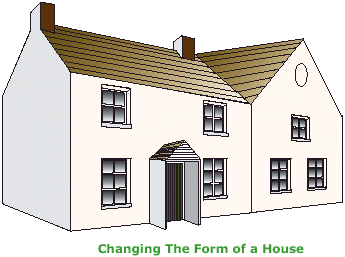Non-Rear extensions
Extensions other than to the Rear of Property

- It is very important that any extension should be compatible with the design of the original building. The form or shape of the original house should indicate the type of extension which will be appropriate, paying careful attention to roof shape, size and general proportions. A large box-like construction at the side of a pitched roof house, for example, will normally be unacceptable.
- Where the original house is semi-detached it is important that any two storey extension should not upset the balanced appearance of the whole building. Semi-detached properties are designed and built as a matching pair and typically have the same detailing and type of materials.
Balance
It is therefore very important to ensure that a new extension does not destroy the symmetrical, balanced design of the original houses. The easiest way to protect the symmetry is to "step" any extension back from the front elevation by at least 1 metres.


- Where general proportions would not be upset, or if the house is detached, the extension could be integrated into the original design of the house in such a way that it does not appear to be an obvious addition. This would normally require matching the design of the original house in all respects. In some cases however, and often, where the house is detached, it may be possible to use the extension to completely change the overall form of the house.
- Some dwellings have a character and charm which can be destroyed by an excessively large or unsympathetic extension. To retain the contribution that such buildings make to the environment, extensions should be kept to an absolute minimum.
In open countryside, in particular the original gross floor area of dwelling should not as a rough guide be more than doubled. In addition, if the original ceiling levels are low, the extension should be carefully designed to avoid having an overbearing impact upon the existing house.

- In normal circumstances it is often desirable to maintain a distance of 1 metre between a common boundary and the wall of any two-storey extension at the side for ease of maintenance and for rear access. If any extension has to be built close to a common boundary then care should be taken to avoid terracing. A wide extension that significantly reduces the distance between the blocks of "semi's " or detached dwellings can lead to an undesirable "terracing" effect. This can normally be overcome by setting back the extension from the front wall of the house. (As a general guide a set back of at least 1.5 metres is considered to be appropriate).
- Where the original house has a pitched roof, any extension of the upper floor should also present a pitched roof appearance to the street and to any other public areas. This should, ideally, be complementary in shape to that of the existing house, although where the extension is not too prominent a combination of a pitched and flat roof may be acceptable.